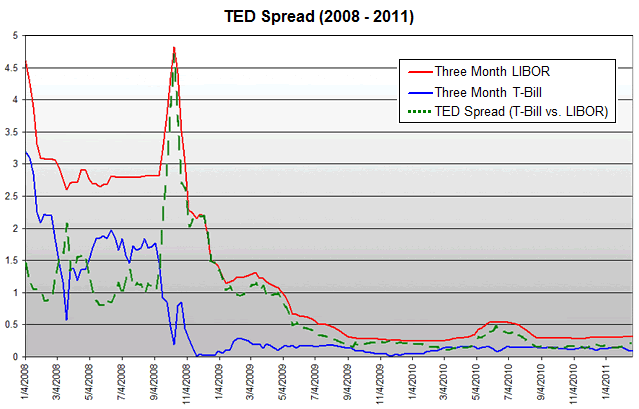What is a TED Spread?
The TED spread was originally calculated as the difference between interest rates on 3-month T-bills and 3-month Eurodollar contracts with identical expiration months. The acronym is derived from the word 'Treasuries' and the ticker symbol for Eurodollars, which is ED.
Today, the TED spread is calculated as the difference between interest rates on 3-month T-bills and 3-month LIBOR (London Interbank Offered Rate).
How Does a TED Spread Work?
The TED spread is a handy and accurate indicator of credit risk because U.S. T-bills are universally categorized as 'risk-free' rate, while LIBOR reflects the credit risk that large, international banks assume when they lend money to each other. So the difference between what investors charge the U.S. government for money and what investors charge large banks for money (the difference in interest rates being 'the spread') is a good proxy for global fluctuations in credit risk.
The TED spread is an instantaneous gauge of perceived risk in the global financial system. As the TED spread widens, investors believe that credit risk, and therefore the risk of default, is growing. Conversely, as the spread shrinks, the risk of default is lessening.
Typically, the size of the spread is designated in basis points (bps, pronounced 'beeps'). For example, if the T-bill rate is 5.10% and 3-month LIBOR is 5.50%, the TED spread is 40 bps. Over long periods of time the TED spread fluctuates within a wide range, but historically it has roughly stayed within 10-50 bps (0.1% and 0.5%).
During financial crises, the TED spread can grow quite wide. During the subprime mortgage crisis of 2008, the TED spread burgeoned to the truly disturbing range of 150-200 bps. When the financial sector collapsed and stocks plummeted in September 2008, the TED spread exceeded 300 bps, shattering the previous record established during the Black Monday crash of 1987.

Why Does a TED Spread Matter?
Investors watch the TED spread as a catalyst for action. If it looks like the TED spread is trending upwards, investors will respond to the perceived increase in credit risk by flocking to safe investments like Treasuries.



